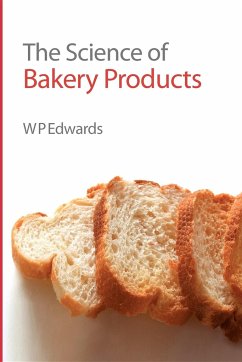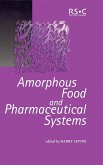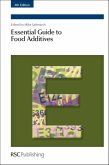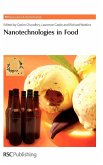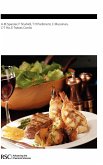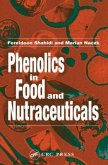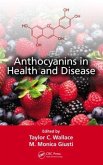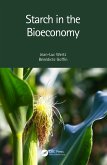William P Edwards
Science of Bakery Products
William P Edwards
Science of Bakery Products
- Gebundenes Buch
- Merkliste
- Auf die Merkliste
- Bewerten Bewerten
- Teilen
- Produkt teilen
- Produkterinnerung
- Produkterinnerung
Ever wondered why bread rises? Or why dough needs to rest? From cakes and biscuits to flat breads and loaves, the diversity of products is remarkable as is the chemistry behind these processes. This book explains the science behind bread making and other baked goods. It looks at the chemistry of the ingredients, flour treatments, flour testing and baking machinery. Individual chapters focus on the science of breads, pastry, biscuits, wafers and cakes. The book also looks at experiments and methods and discusses ideas for the future. This is an interesting and easy to read book, aimed at anyone…mehr
Andere Kunden interessierten sich auch für
![Amorphous Food and Pharmaceutical Systems Amorphous Food and Pharmaceutical Systems]() LevineAmorphous Food and Pharmaceutical Systems132,99 €
LevineAmorphous Food and Pharmaceutical Systems132,99 €![Essential Guide to Food Additives Essential Guide to Food Additives]() Essential Guide to Food Additives92,99 €
Essential Guide to Food Additives92,99 €![Nanotechnologies in Food Nanotechnologies in Food]() Nanotechnologies in Food144,99 €
Nanotechnologies in Food144,99 €![Food Flavor and Chemistry Food Flavor and Chemistry]() SpanierFood Flavor and Chemistry161,99 €
SpanierFood Flavor and Chemistry161,99 €![Phenolics in Food and Nutraceuticals Phenolics in Food and Nutraceuticals]() Fereidoon ShahidiPhenolics in Food and Nutraceuticals324,99 €
Fereidoon ShahidiPhenolics in Food and Nutraceuticals324,99 €![Anthocyanins in Health and Disease Anthocyanins in Health and Disease]() Anthocyanins in Health and Disease230,99 €
Anthocyanins in Health and Disease230,99 €![Starch in the Bioeconomy Starch in the Bioeconomy]() Jean-Luc WertzStarch in the Bioeconomy139,99 €
Jean-Luc WertzStarch in the Bioeconomy139,99 €-
-
-
Ever wondered why bread rises? Or why dough needs to rest? From cakes and biscuits to flat breads and loaves, the diversity of products is remarkable as is the chemistry behind these processes. This book explains the science behind bread making and other baked goods. It looks at the chemistry of the ingredients, flour treatments, flour testing and baking machinery. Individual chapters focus on the science of breads, pastry, biscuits, wafers and cakes. The book also looks at experiments and methods and discusses ideas for the future. This is an interesting and easy to read book, aimed at anyone with an interest in everyday chemistry or working in the food industry.
Hinweis: Dieser Artikel kann nur an eine deutsche Lieferadresse ausgeliefert werden.
Hinweis: Dieser Artikel kann nur an eine deutsche Lieferadresse ausgeliefert werden.
Produktdetails
- Produktdetails
- Verlag: RSC Publishing
- Seitenzahl: 273
- Erscheinungstermin: 1. Juni 2007
- Englisch
- Abmessung: 232mm x 160mm x 21mm
- Gewicht: 553g
- ISBN-13: 9780854044863
- ISBN-10: 0854044868
- Artikelnr.: 22954835
- Herstellerkennzeichnung
- Libri GmbH
- Europaallee 1
- 36244 Bad Hersfeld
- gpsr@libri.de
- Verlag: RSC Publishing
- Seitenzahl: 273
- Erscheinungstermin: 1. Juni 2007
- Englisch
- Abmessung: 232mm x 160mm x 21mm
- Gewicht: 553g
- ISBN-13: 9780854044863
- ISBN-10: 0854044868
- Artikelnr.: 22954835
- Herstellerkennzeichnung
- Libri GmbH
- Europaallee 1
- 36244 Bad Hersfeld
- gpsr@libri.de
Chapter 1: Introduction
1.1: History
1.2: Language and Units
1.3: Food Law
1.3.1:Bread and Food Law
1.3.2: Health and Safety
Chapter 2: Science
2.1: Basic Science
2.1.1: Stability
2.1.2: Water Activity
2.1.3: The Equilibrium Relative Humidity
2.1.4: The Dew Point
2.2: Colligative Properties
2.2.1: Boiling Points
2.2.2: Measuring Vacuum
2.3: pH
2.4: Polarimetry
2.5: The Maillard Reaction
2.5.1: Sulfur-containing Amino Acids
2.5.2: Products from Proline
2.5.3: Strecker Aldehydes
2.6: Densimetry
2.7: Refractive Index
2.8: Buffers
2.9: Analytical Chemistry
2.9.1: Water Content
2.9.2: Sugar Analysis
2.10: Emulsions
2.11: The Chemistry of Oils and Fats
2.11: Classifications of Fatty Acids
2.11.2: The Hydrogenation of Fats and Oils
2.11.3: Fat Specifications
2.11.4: Deterioration of Fats
2.12: Water Migration
2.12.1: Barrier Methods
2.12: Matching the Water Activity
2.13
The Science of Proteins
2.13.1: History
2.13.2: Classification of Cereal Proteins
2.13.3: Glutenins
2.14: The Science of Starch
2.14.1: Gelatinization
2.14.2: Retrogradation
2.14.3: Starch Molecules
2.14.4: A Comparison of the Structure of Amylose and Amylopectin
2.14.5: Modified Starches
2.15: Nutrition
2.15.1: Nutritional Needs
2.15.2: Food Groups
2.15.3: The Glycemic
Index: 2.15.4:Trace Elements
2.15.5: Vitamins
2.15.6: Nutritional Labelling
2.16: Food Allergy and Intolerance
2.16.1: Immunoglobulin E (IgE)-mediated Food Allergies
2.16.2: Cell-mediated Food Allergies
2.16.3: Food Intolerance
2.17: The Science of Aerated Products
2.17.1: Making the Bubbles or Leavening
2.17.2: Stabilising the Foam
2.17.3: Fat in Bread
Chapter 3: Raw Materials
3.1: Grains
3.1.1: Wheat
3.1.2: Barley
3.1.3: Rye
3.1.4: Maize
3.1.5: Dried Gluten
3.1.6: Soy Beans
3.1.7: Margarine
3.2: Milling
3.3: Grades of Flour
3.3.1
Top Grade
3.3.2: Baker's Grade
3.3.3: Baker's Grade
3.3.4: Euro Baker's Grade
3.4: Types of Flour
3.4.1: Chorleywood Bread Flour
3.4.2: Patent Flours
3.4.3: Soft Flours
3.4.4: Wholemeal Flours
3.4.5: Brown Flour
3.4.6: Low Moisture Flour
3.5: Leavening Agents
3.5.1: Air
3.5.2: Water or Steam
3.5.3 Yeast
3.5.4: Chemical Leavening
3.6: Flour Treatments
3.6.1: Introduction
3.6.2: Wholemeal Flour
3.6.3: Bleaching
3.6.4: Oxidative Improvers
3.6.5: Reducing Agents
3.6.6: Cake Flours
3.6.7: Sources of Enzymes
3.6.8: Potassium Bromate Health and Legislation
3.7: Starch Excluding Flour
3.8: Fats
3.8.1: Fat-containing Ingredients
3.8.2: Emulsifiers in Bread
3.9: Emulsifiers
3.9.1: Foams
3.9.2: Lecithin
3.9.3: Sucrose Esters E473
3.9.4: Eggs
3.9.5: Uses of Emulsifiers in Bakery Products
3.10: Colours
3.10.1: Technical Requirements of Colours in Bakery Products
3.10.2: Synthetic Colours
3.10.3: Natural Colours
3.11: Falvours
3.11.1: Natural Flavours
3.11.2: The Image of Natural Products
3.11.3: Nature Identical Flavourings
3.11.4: Synthetic Flavours
3.11.5: Dosing
3.11.6: Developments in Flavours
3.12 Antioxidants
3.12.1: Synthetic Antioxidants
3.12.2: Tocopherols
3.13: Sugars
3.13.1: Molasses and Treacle
3.13.2: Invert Sugar
3.13.3: Glucose Syrup (Corn Syrup)
3.13.4: Fructose
3.13.5: Dextrose
3.13.6: Lactose
3.14: Dairy Ingredients
3.14.1: Sweetened Condensed Milk
3.14.2: Evaporated Milk (Unsweetened Condensed Milk)
3.14.3: Milk Powder
3.14.4: Butter
3.14.5: Butter Oil (Anhydrous Milk Fat)
3.14.6: Whey
3.14.7: Vegetable Fats
3.15: Gums and Gelling Agents or Hydrocolloids 3.15.1: Agar Agar E406
3.15.2: Alginates E401
3.15.3: Carrageenan
3.15.4: Gelatine
3.15.5: Gellan Gum (E418)
3.15.6: Gum Acacia also known as Gum Arabic E414
3.15.7: Guar Gum
3.15.8: Pectin
3.15.9: Starch
3.15.10: Locust Bean or Carob Bean Gum
3.15.11: Xanthan Gum
3.15.12: Egg Albumen
Chapter 4: Analytical Chemistry
4.1: Introduction
4.2: Methods
4.2.1: The Kjeldahl Method
4.2.2: Near-infrared Spectroscopy
4.2.3: Water Measurement: Fat Content
4.2.4: Chromatography
Chapter 5: Flour Testing
5.1: Introduction
5.1.1: Analytical tests
5.1.2: Empirical tests
5.1.3: Test Baking
5.2: Empirical Testing Regimes
5.2.1: The Haberg Falling Number
5.2.2: Chopin Alveograph
5.2.3: Brabender Instruments
5.2.4: The Mixograph
5.2.5: The Grade Colour
5.2.6: The Sodium Dodecyl Sulfate (SDS) Test
5.2.7: The Cookie Flour Test
Chapter 6: Bakery Machinery
6.1: Introduction
6.2: Mixing
6.2.1: Bread Dough Mixers
6.2.2: Biscuit Dough Mixers
6.2.3: Cake Mixers
6.2.4: Pastry Mixers
6.3: Measuring and Weighing Ingredients
6.4: Proving and Retarding
6.5: Shaping and Panning
6.6: Scaling
6.7: Baking
6.8: Extrusion
6.8.1: Classification of Extruders
6.8.2: Extrusion Cooking
Chapter 7: Bread Making
7.1: The Chemistry of Dough Development
7.2: The Making of Bread
7.2.1: Unleavened Bread
7.2.2: Sour Dough Bread
7.2.3: Bulk Fermentation
7.2.4: Sponge Batter or Sponge Dough of Flour Brew
7.2.5: Chorleywood Bread Process
7.2.6: Activated Dough Development (ADD)
7.2.7: The Spiral Mixer Process
7.2.8:Other Mechanical Dough Developments Methods
7.2.9: Continuous Processes
7.2.10: Emergency No Time Process
7.2.11: Gas Injection Process
7.2.12: Part-baked Loaves
7.2.13: French Bread
7.3: Other Breads
7.3.1: Brown and Wholemeal
7.3.2: Wheatgerm Breads
7.3.3: High Protein Breads
7.3.4: High Fibre and Multi-grain Breads
7.3.5: Soft Grain Breads
7.3.6: Ethnic Multigrain Breads
7.3.7: Slimming and Health High Fibre Breads
7.3.8: Bread with Added Malt Grains
7.3.9: Bread Containing Cereals other than Wheat
7.3.10 Crispbread
7.3.11: Bread for Special Dietry Needs
7.3.12: War and famine Breads
7.4: Other Variants of Bread
7.4.1: Flat Breads
7.4.2: Pitta Bread
7.4.3: Muffins
7.4.4: Crumpets
7.4.5: Pizza
7.4.7: Rich Dough Products
7.4.8: Hot Cross Buns
7.4.9: Danish Pastries
7.4.10: Pretzels
7.4.11: Not Baked
Chapter 8: Products Other Than Bread
8.1: Puff Pastry
8.1.1: Methods
8.1.2: Types of Flour
8.1.3: The Type of Fat
8.1.4: Additives
8.1.5: Re-work
8.2: Short Pastry
8.3: Hot Water Pastry
8.4: Science of Biscuits
8.4.1: Flour for Biscuits
8.4.2: Fats
8.4.3: Sugars
8.4.4: Milk and Other Dairy Ingredients
8.4.5: Other Cereal Ingredients
8.4.6: Mixing Biscuits
8.4.7: Types of Dough
8.4.8: Shaping Biscuits
8.4.9: Baking Biscuits
8.4.10: Packaging
8.5: Science of Wafers
8.5.1: Raising Agents
8.5.2: Flour for Wafers
8.5.3: Production Process
8.5.4: Maturing Wafers
8.6: Cakes
8.6.1: Introdcution
8.6.2: Shelf Life
8.6.3: Rich Fruit Cakes
8.6.4: Long-life Sponge cakes
8.6.5: Making Sponge Cakes
8.6.6: A Comparison of Cake Making Methods
8.7: Miscellaneous Chemically Leavened Products
8.7.1: Doughnuts
8.7.2: Eclairs
8.7.3: French Crullers
8.7.4: Soda Bread
Chapter 9: Bread-making Experiments
9.1: Introduction
9.2: Health and Safety
9.3: Yield
9.4: Loaf testing
9.4.1: Tasting
9.5: Bread making
9.5.1: Recipe
9.5.2: Straight Method
9.5.3: Proving
9.5.4: Knock Back
9.5.5: Scaling and Dividing
9.5.6: Second Proving
9.5.7: Baking
9.6: Sponge Batter
9.6.1
Proving
9.7: Variations to the Recipe
9.7.1: Variation 1: Compare the Effect of Leaving out the Sugar
9.7.2: Variation 2: Compare the Effect of Using Vegetable Oil Instead of Hard Fat
9.7.3: Variation 3: Compare the Effect of Using No Fat Instead of Hard Fat
9.7.4: Variation 4 Leave Out the Salt
9.7.5 Variation 5: Proving in the Sponge Batter Method
9.7.6: Variation 6: Hand Mixing vs Machine Mixing
9.7.7: Variation 7: Comparison of Two Different Flours
9.7.8: Variation 8: Testing Different Levels of Water Addition
9.7.9: Variation 9: Wholemeal Flours
9.8: Report Writing
Chapter 10: The Future
10.1: General Outlook
10.2: Dietary Trends
Glossary
Bibliography
Subject Index
1.1: History
1.2: Language and Units
1.3: Food Law
1.3.1:Bread and Food Law
1.3.2: Health and Safety
Chapter 2: Science
2.1: Basic Science
2.1.1: Stability
2.1.2: Water Activity
2.1.3: The Equilibrium Relative Humidity
2.1.4: The Dew Point
2.2: Colligative Properties
2.2.1: Boiling Points
2.2.2: Measuring Vacuum
2.3: pH
2.4: Polarimetry
2.5: The Maillard Reaction
2.5.1: Sulfur-containing Amino Acids
2.5.2: Products from Proline
2.5.3: Strecker Aldehydes
2.6: Densimetry
2.7: Refractive Index
2.8: Buffers
2.9: Analytical Chemistry
2.9.1: Water Content
2.9.2: Sugar Analysis
2.10: Emulsions
2.11: The Chemistry of Oils and Fats
2.11: Classifications of Fatty Acids
2.11.2: The Hydrogenation of Fats and Oils
2.11.3: Fat Specifications
2.11.4: Deterioration of Fats
2.12: Water Migration
2.12.1: Barrier Methods
2.12: Matching the Water Activity
2.13
The Science of Proteins
2.13.1: History
2.13.2: Classification of Cereal Proteins
2.13.3: Glutenins
2.14: The Science of Starch
2.14.1: Gelatinization
2.14.2: Retrogradation
2.14.3: Starch Molecules
2.14.4: A Comparison of the Structure of Amylose and Amylopectin
2.14.5: Modified Starches
2.15: Nutrition
2.15.1: Nutritional Needs
2.15.2: Food Groups
2.15.3: The Glycemic
Index: 2.15.4:Trace Elements
2.15.5: Vitamins
2.15.6: Nutritional Labelling
2.16: Food Allergy and Intolerance
2.16.1: Immunoglobulin E (IgE)-mediated Food Allergies
2.16.2: Cell-mediated Food Allergies
2.16.3: Food Intolerance
2.17: The Science of Aerated Products
2.17.1: Making the Bubbles or Leavening
2.17.2: Stabilising the Foam
2.17.3: Fat in Bread
Chapter 3: Raw Materials
3.1: Grains
3.1.1: Wheat
3.1.2: Barley
3.1.3: Rye
3.1.4: Maize
3.1.5: Dried Gluten
3.1.6: Soy Beans
3.1.7: Margarine
3.2: Milling
3.3: Grades of Flour
3.3.1
Top Grade
3.3.2: Baker's Grade
3.3.3: Baker's Grade
3.3.4: Euro Baker's Grade
3.4: Types of Flour
3.4.1: Chorleywood Bread Flour
3.4.2: Patent Flours
3.4.3: Soft Flours
3.4.4: Wholemeal Flours
3.4.5: Brown Flour
3.4.6: Low Moisture Flour
3.5: Leavening Agents
3.5.1: Air
3.5.2: Water or Steam
3.5.3 Yeast
3.5.4: Chemical Leavening
3.6: Flour Treatments
3.6.1: Introduction
3.6.2: Wholemeal Flour
3.6.3: Bleaching
3.6.4: Oxidative Improvers
3.6.5: Reducing Agents
3.6.6: Cake Flours
3.6.7: Sources of Enzymes
3.6.8: Potassium Bromate Health and Legislation
3.7: Starch Excluding Flour
3.8: Fats
3.8.1: Fat-containing Ingredients
3.8.2: Emulsifiers in Bread
3.9: Emulsifiers
3.9.1: Foams
3.9.2: Lecithin
3.9.3: Sucrose Esters E473
3.9.4: Eggs
3.9.5: Uses of Emulsifiers in Bakery Products
3.10: Colours
3.10.1: Technical Requirements of Colours in Bakery Products
3.10.2: Synthetic Colours
3.10.3: Natural Colours
3.11: Falvours
3.11.1: Natural Flavours
3.11.2: The Image of Natural Products
3.11.3: Nature Identical Flavourings
3.11.4: Synthetic Flavours
3.11.5: Dosing
3.11.6: Developments in Flavours
3.12 Antioxidants
3.12.1: Synthetic Antioxidants
3.12.2: Tocopherols
3.13: Sugars
3.13.1: Molasses and Treacle
3.13.2: Invert Sugar
3.13.3: Glucose Syrup (Corn Syrup)
3.13.4: Fructose
3.13.5: Dextrose
3.13.6: Lactose
3.14: Dairy Ingredients
3.14.1: Sweetened Condensed Milk
3.14.2: Evaporated Milk (Unsweetened Condensed Milk)
3.14.3: Milk Powder
3.14.4: Butter
3.14.5: Butter Oil (Anhydrous Milk Fat)
3.14.6: Whey
3.14.7: Vegetable Fats
3.15: Gums and Gelling Agents or Hydrocolloids 3.15.1: Agar Agar E406
3.15.2: Alginates E401
3.15.3: Carrageenan
3.15.4: Gelatine
3.15.5: Gellan Gum (E418)
3.15.6: Gum Acacia also known as Gum Arabic E414
3.15.7: Guar Gum
3.15.8: Pectin
3.15.9: Starch
3.15.10: Locust Bean or Carob Bean Gum
3.15.11: Xanthan Gum
3.15.12: Egg Albumen
Chapter 4: Analytical Chemistry
4.1: Introduction
4.2: Methods
4.2.1: The Kjeldahl Method
4.2.2: Near-infrared Spectroscopy
4.2.3: Water Measurement: Fat Content
4.2.4: Chromatography
Chapter 5: Flour Testing
5.1: Introduction
5.1.1: Analytical tests
5.1.2: Empirical tests
5.1.3: Test Baking
5.2: Empirical Testing Regimes
5.2.1: The Haberg Falling Number
5.2.2: Chopin Alveograph
5.2.3: Brabender Instruments
5.2.4: The Mixograph
5.2.5: The Grade Colour
5.2.6: The Sodium Dodecyl Sulfate (SDS) Test
5.2.7: The Cookie Flour Test
Chapter 6: Bakery Machinery
6.1: Introduction
6.2: Mixing
6.2.1: Bread Dough Mixers
6.2.2: Biscuit Dough Mixers
6.2.3: Cake Mixers
6.2.4: Pastry Mixers
6.3: Measuring and Weighing Ingredients
6.4: Proving and Retarding
6.5: Shaping and Panning
6.6: Scaling
6.7: Baking
6.8: Extrusion
6.8.1: Classification of Extruders
6.8.2: Extrusion Cooking
Chapter 7: Bread Making
7.1: The Chemistry of Dough Development
7.2: The Making of Bread
7.2.1: Unleavened Bread
7.2.2: Sour Dough Bread
7.2.3: Bulk Fermentation
7.2.4: Sponge Batter or Sponge Dough of Flour Brew
7.2.5: Chorleywood Bread Process
7.2.6: Activated Dough Development (ADD)
7.2.7: The Spiral Mixer Process
7.2.8:Other Mechanical Dough Developments Methods
7.2.9: Continuous Processes
7.2.10: Emergency No Time Process
7.2.11: Gas Injection Process
7.2.12: Part-baked Loaves
7.2.13: French Bread
7.3: Other Breads
7.3.1: Brown and Wholemeal
7.3.2: Wheatgerm Breads
7.3.3: High Protein Breads
7.3.4: High Fibre and Multi-grain Breads
7.3.5: Soft Grain Breads
7.3.6: Ethnic Multigrain Breads
7.3.7: Slimming and Health High Fibre Breads
7.3.8: Bread with Added Malt Grains
7.3.9: Bread Containing Cereals other than Wheat
7.3.10 Crispbread
7.3.11: Bread for Special Dietry Needs
7.3.12: War and famine Breads
7.4: Other Variants of Bread
7.4.1: Flat Breads
7.4.2: Pitta Bread
7.4.3: Muffins
7.4.4: Crumpets
7.4.5: Pizza
7.4.7: Rich Dough Products
7.4.8: Hot Cross Buns
7.4.9: Danish Pastries
7.4.10: Pretzels
7.4.11: Not Baked
Chapter 8: Products Other Than Bread
8.1: Puff Pastry
8.1.1: Methods
8.1.2: Types of Flour
8.1.3: The Type of Fat
8.1.4: Additives
8.1.5: Re-work
8.2: Short Pastry
8.3: Hot Water Pastry
8.4: Science of Biscuits
8.4.1: Flour for Biscuits
8.4.2: Fats
8.4.3: Sugars
8.4.4: Milk and Other Dairy Ingredients
8.4.5: Other Cereal Ingredients
8.4.6: Mixing Biscuits
8.4.7: Types of Dough
8.4.8: Shaping Biscuits
8.4.9: Baking Biscuits
8.4.10: Packaging
8.5: Science of Wafers
8.5.1: Raising Agents
8.5.2: Flour for Wafers
8.5.3: Production Process
8.5.4: Maturing Wafers
8.6: Cakes
8.6.1: Introdcution
8.6.2: Shelf Life
8.6.3: Rich Fruit Cakes
8.6.4: Long-life Sponge cakes
8.6.5: Making Sponge Cakes
8.6.6: A Comparison of Cake Making Methods
8.7: Miscellaneous Chemically Leavened Products
8.7.1: Doughnuts
8.7.2: Eclairs
8.7.3: French Crullers
8.7.4: Soda Bread
Chapter 9: Bread-making Experiments
9.1: Introduction
9.2: Health and Safety
9.3: Yield
9.4: Loaf testing
9.4.1: Tasting
9.5: Bread making
9.5.1: Recipe
9.5.2: Straight Method
9.5.3: Proving
9.5.4: Knock Back
9.5.5: Scaling and Dividing
9.5.6: Second Proving
9.5.7: Baking
9.6: Sponge Batter
9.6.1
Proving
9.7: Variations to the Recipe
9.7.1: Variation 1: Compare the Effect of Leaving out the Sugar
9.7.2: Variation 2: Compare the Effect of Using Vegetable Oil Instead of Hard Fat
9.7.3: Variation 3: Compare the Effect of Using No Fat Instead of Hard Fat
9.7.4: Variation 4 Leave Out the Salt
9.7.5 Variation 5: Proving in the Sponge Batter Method
9.7.6: Variation 6: Hand Mixing vs Machine Mixing
9.7.7: Variation 7: Comparison of Two Different Flours
9.7.8: Variation 8: Testing Different Levels of Water Addition
9.7.9: Variation 9: Wholemeal Flours
9.8: Report Writing
Chapter 10: The Future
10.1: General Outlook
10.2: Dietary Trends
Glossary
Bibliography
Subject Index
Chapter 1: Introduction
1.1: History
1.2: Language and Units
1.3: Food Law
1.3.1:Bread and Food Law
1.3.2: Health and Safety
Chapter 2: Science
2.1: Basic Science
2.1.1: Stability
2.1.2: Water Activity
2.1.3: The Equilibrium Relative Humidity
2.1.4: The Dew Point
2.2: Colligative Properties
2.2.1: Boiling Points
2.2.2: Measuring Vacuum
2.3: pH
2.4: Polarimetry
2.5: The Maillard Reaction
2.5.1: Sulfur-containing Amino Acids
2.5.2: Products from Proline
2.5.3: Strecker Aldehydes
2.6: Densimetry
2.7: Refractive Index
2.8: Buffers
2.9: Analytical Chemistry
2.9.1: Water Content
2.9.2: Sugar Analysis
2.10: Emulsions
2.11: The Chemistry of Oils and Fats
2.11: Classifications of Fatty Acids
2.11.2: The Hydrogenation of Fats and Oils
2.11.3: Fat Specifications
2.11.4: Deterioration of Fats
2.12: Water Migration
2.12.1: Barrier Methods
2.12: Matching the Water Activity
2.13
The Science of Proteins
2.13.1: History
2.13.2: Classification of Cereal Proteins
2.13.3: Glutenins
2.14: The Science of Starch
2.14.1: Gelatinization
2.14.2: Retrogradation
2.14.3: Starch Molecules
2.14.4: A Comparison of the Structure of Amylose and Amylopectin
2.14.5: Modified Starches
2.15: Nutrition
2.15.1: Nutritional Needs
2.15.2: Food Groups
2.15.3: The Glycemic
Index: 2.15.4:Trace Elements
2.15.5: Vitamins
2.15.6: Nutritional Labelling
2.16: Food Allergy and Intolerance
2.16.1: Immunoglobulin E (IgE)-mediated Food Allergies
2.16.2: Cell-mediated Food Allergies
2.16.3: Food Intolerance
2.17: The Science of Aerated Products
2.17.1: Making the Bubbles or Leavening
2.17.2: Stabilising the Foam
2.17.3: Fat in Bread
Chapter 3: Raw Materials
3.1: Grains
3.1.1: Wheat
3.1.2: Barley
3.1.3: Rye
3.1.4: Maize
3.1.5: Dried Gluten
3.1.6: Soy Beans
3.1.7: Margarine
3.2: Milling
3.3: Grades of Flour
3.3.1
Top Grade
3.3.2: Baker's Grade
3.3.3: Baker's Grade
3.3.4: Euro Baker's Grade
3.4: Types of Flour
3.4.1: Chorleywood Bread Flour
3.4.2: Patent Flours
3.4.3: Soft Flours
3.4.4: Wholemeal Flours
3.4.5: Brown Flour
3.4.6: Low Moisture Flour
3.5: Leavening Agents
3.5.1: Air
3.5.2: Water or Steam
3.5.3 Yeast
3.5.4: Chemical Leavening
3.6: Flour Treatments
3.6.1: Introduction
3.6.2: Wholemeal Flour
3.6.3: Bleaching
3.6.4: Oxidative Improvers
3.6.5: Reducing Agents
3.6.6: Cake Flours
3.6.7: Sources of Enzymes
3.6.8: Potassium Bromate Health and Legislation
3.7: Starch Excluding Flour
3.8: Fats
3.8.1: Fat-containing Ingredients
3.8.2: Emulsifiers in Bread
3.9: Emulsifiers
3.9.1: Foams
3.9.2: Lecithin
3.9.3: Sucrose Esters E473
3.9.4: Eggs
3.9.5: Uses of Emulsifiers in Bakery Products
3.10: Colours
3.10.1: Technical Requirements of Colours in Bakery Products
3.10.2: Synthetic Colours
3.10.3: Natural Colours
3.11: Falvours
3.11.1: Natural Flavours
3.11.2: The Image of Natural Products
3.11.3: Nature Identical Flavourings
3.11.4: Synthetic Flavours
3.11.5: Dosing
3.11.6: Developments in Flavours
3.12 Antioxidants
3.12.1: Synthetic Antioxidants
3.12.2: Tocopherols
3.13: Sugars
3.13.1: Molasses and Treacle
3.13.2: Invert Sugar
3.13.3: Glucose Syrup (Corn Syrup)
3.13.4: Fructose
3.13.5: Dextrose
3.13.6: Lactose
3.14: Dairy Ingredients
3.14.1: Sweetened Condensed Milk
3.14.2: Evaporated Milk (Unsweetened Condensed Milk)
3.14.3: Milk Powder
3.14.4: Butter
3.14.5: Butter Oil (Anhydrous Milk Fat)
3.14.6: Whey
3.14.7: Vegetable Fats
3.15: Gums and Gelling Agents or Hydrocolloids 3.15.1: Agar Agar E406
3.15.2: Alginates E401
3.15.3: Carrageenan
3.15.4: Gelatine
3.15.5: Gellan Gum (E418)
3.15.6: Gum Acacia also known as Gum Arabic E414
3.15.7: Guar Gum
3.15.8: Pectin
3.15.9: Starch
3.15.10: Locust Bean or Carob Bean Gum
3.15.11: Xanthan Gum
3.15.12: Egg Albumen
Chapter 4: Analytical Chemistry
4.1: Introduction
4.2: Methods
4.2.1: The Kjeldahl Method
4.2.2: Near-infrared Spectroscopy
4.2.3: Water Measurement: Fat Content
4.2.4: Chromatography
Chapter 5: Flour Testing
5.1: Introduction
5.1.1: Analytical tests
5.1.2: Empirical tests
5.1.3: Test Baking
5.2: Empirical Testing Regimes
5.2.1: The Haberg Falling Number
5.2.2: Chopin Alveograph
5.2.3: Brabender Instruments
5.2.4: The Mixograph
5.2.5: The Grade Colour
5.2.6: The Sodium Dodecyl Sulfate (SDS) Test
5.2.7: The Cookie Flour Test
Chapter 6: Bakery Machinery
6.1: Introduction
6.2: Mixing
6.2.1: Bread Dough Mixers
6.2.2: Biscuit Dough Mixers
6.2.3: Cake Mixers
6.2.4: Pastry Mixers
6.3: Measuring and Weighing Ingredients
6.4: Proving and Retarding
6.5: Shaping and Panning
6.6: Scaling
6.7: Baking
6.8: Extrusion
6.8.1: Classification of Extruders
6.8.2: Extrusion Cooking
Chapter 7: Bread Making
7.1: The Chemistry of Dough Development
7.2: The Making of Bread
7.2.1: Unleavened Bread
7.2.2: Sour Dough Bread
7.2.3: Bulk Fermentation
7.2.4: Sponge Batter or Sponge Dough of Flour Brew
7.2.5: Chorleywood Bread Process
7.2.6: Activated Dough Development (ADD)
7.2.7: The Spiral Mixer Process
7.2.8:Other Mechanical Dough Developments Methods
7.2.9: Continuous Processes
7.2.10: Emergency No Time Process
7.2.11: Gas Injection Process
7.2.12: Part-baked Loaves
7.2.13: French Bread
7.3: Other Breads
7.3.1: Brown and Wholemeal
7.3.2: Wheatgerm Breads
7.3.3: High Protein Breads
7.3.4: High Fibre and Multi-grain Breads
7.3.5: Soft Grain Breads
7.3.6: Ethnic Multigrain Breads
7.3.7: Slimming and Health High Fibre Breads
7.3.8: Bread with Added Malt Grains
7.3.9: Bread Containing Cereals other than Wheat
7.3.10 Crispbread
7.3.11: Bread for Special Dietry Needs
7.3.12: War and famine Breads
7.4: Other Variants of Bread
7.4.1: Flat Breads
7.4.2: Pitta Bread
7.4.3: Muffins
7.4.4: Crumpets
7.4.5: Pizza
7.4.7: Rich Dough Products
7.4.8: Hot Cross Buns
7.4.9: Danish Pastries
7.4.10: Pretzels
7.4.11: Not Baked
Chapter 8: Products Other Than Bread
8.1: Puff Pastry
8.1.1: Methods
8.1.2: Types of Flour
8.1.3: The Type of Fat
8.1.4: Additives
8.1.5: Re-work
8.2: Short Pastry
8.3: Hot Water Pastry
8.4: Science of Biscuits
8.4.1: Flour for Biscuits
8.4.2: Fats
8.4.3: Sugars
8.4.4: Milk and Other Dairy Ingredients
8.4.5: Other Cereal Ingredients
8.4.6: Mixing Biscuits
8.4.7: Types of Dough
8.4.8: Shaping Biscuits
8.4.9: Baking Biscuits
8.4.10: Packaging
8.5: Science of Wafers
8.5.1: Raising Agents
8.5.2: Flour for Wafers
8.5.3: Production Process
8.5.4: Maturing Wafers
8.6: Cakes
8.6.1: Introdcution
8.6.2: Shelf Life
8.6.3: Rich Fruit Cakes
8.6.4: Long-life Sponge cakes
8.6.5: Making Sponge Cakes
8.6.6: A Comparison of Cake Making Methods
8.7: Miscellaneous Chemically Leavened Products
8.7.1: Doughnuts
8.7.2: Eclairs
8.7.3: French Crullers
8.7.4: Soda Bread
Chapter 9: Bread-making Experiments
9.1: Introduction
9.2: Health and Safety
9.3: Yield
9.4: Loaf testing
9.4.1: Tasting
9.5: Bread making
9.5.1: Recipe
9.5.2: Straight Method
9.5.3: Proving
9.5.4: Knock Back
9.5.5: Scaling and Dividing
9.5.6: Second Proving
9.5.7: Baking
9.6: Sponge Batter
9.6.1
Proving
9.7: Variations to the Recipe
9.7.1: Variation 1: Compare the Effect of Leaving out the Sugar
9.7.2: Variation 2: Compare the Effect of Using Vegetable Oil Instead of Hard Fat
9.7.3: Variation 3: Compare the Effect of Using No Fat Instead of Hard Fat
9.7.4: Variation 4 Leave Out the Salt
9.7.5 Variation 5: Proving in the Sponge Batter Method
9.7.6: Variation 6: Hand Mixing vs Machine Mixing
9.7.7: Variation 7: Comparison of Two Different Flours
9.7.8: Variation 8: Testing Different Levels of Water Addition
9.7.9: Variation 9: Wholemeal Flours
9.8: Report Writing
Chapter 10: The Future
10.1: General Outlook
10.2: Dietary Trends
Glossary
Bibliography
Subject Index
1.1: History
1.2: Language and Units
1.3: Food Law
1.3.1:Bread and Food Law
1.3.2: Health and Safety
Chapter 2: Science
2.1: Basic Science
2.1.1: Stability
2.1.2: Water Activity
2.1.3: The Equilibrium Relative Humidity
2.1.4: The Dew Point
2.2: Colligative Properties
2.2.1: Boiling Points
2.2.2: Measuring Vacuum
2.3: pH
2.4: Polarimetry
2.5: The Maillard Reaction
2.5.1: Sulfur-containing Amino Acids
2.5.2: Products from Proline
2.5.3: Strecker Aldehydes
2.6: Densimetry
2.7: Refractive Index
2.8: Buffers
2.9: Analytical Chemistry
2.9.1: Water Content
2.9.2: Sugar Analysis
2.10: Emulsions
2.11: The Chemistry of Oils and Fats
2.11: Classifications of Fatty Acids
2.11.2: The Hydrogenation of Fats and Oils
2.11.3: Fat Specifications
2.11.4: Deterioration of Fats
2.12: Water Migration
2.12.1: Barrier Methods
2.12: Matching the Water Activity
2.13
The Science of Proteins
2.13.1: History
2.13.2: Classification of Cereal Proteins
2.13.3: Glutenins
2.14: The Science of Starch
2.14.1: Gelatinization
2.14.2: Retrogradation
2.14.3: Starch Molecules
2.14.4: A Comparison of the Structure of Amylose and Amylopectin
2.14.5: Modified Starches
2.15: Nutrition
2.15.1: Nutritional Needs
2.15.2: Food Groups
2.15.3: The Glycemic
Index: 2.15.4:Trace Elements
2.15.5: Vitamins
2.15.6: Nutritional Labelling
2.16: Food Allergy and Intolerance
2.16.1: Immunoglobulin E (IgE)-mediated Food Allergies
2.16.2: Cell-mediated Food Allergies
2.16.3: Food Intolerance
2.17: The Science of Aerated Products
2.17.1: Making the Bubbles or Leavening
2.17.2: Stabilising the Foam
2.17.3: Fat in Bread
Chapter 3: Raw Materials
3.1: Grains
3.1.1: Wheat
3.1.2: Barley
3.1.3: Rye
3.1.4: Maize
3.1.5: Dried Gluten
3.1.6: Soy Beans
3.1.7: Margarine
3.2: Milling
3.3: Grades of Flour
3.3.1
Top Grade
3.3.2: Baker's Grade
3.3.3: Baker's Grade
3.3.4: Euro Baker's Grade
3.4: Types of Flour
3.4.1: Chorleywood Bread Flour
3.4.2: Patent Flours
3.4.3: Soft Flours
3.4.4: Wholemeal Flours
3.4.5: Brown Flour
3.4.6: Low Moisture Flour
3.5: Leavening Agents
3.5.1: Air
3.5.2: Water or Steam
3.5.3 Yeast
3.5.4: Chemical Leavening
3.6: Flour Treatments
3.6.1: Introduction
3.6.2: Wholemeal Flour
3.6.3: Bleaching
3.6.4: Oxidative Improvers
3.6.5: Reducing Agents
3.6.6: Cake Flours
3.6.7: Sources of Enzymes
3.6.8: Potassium Bromate Health and Legislation
3.7: Starch Excluding Flour
3.8: Fats
3.8.1: Fat-containing Ingredients
3.8.2: Emulsifiers in Bread
3.9: Emulsifiers
3.9.1: Foams
3.9.2: Lecithin
3.9.3: Sucrose Esters E473
3.9.4: Eggs
3.9.5: Uses of Emulsifiers in Bakery Products
3.10: Colours
3.10.1: Technical Requirements of Colours in Bakery Products
3.10.2: Synthetic Colours
3.10.3: Natural Colours
3.11: Falvours
3.11.1: Natural Flavours
3.11.2: The Image of Natural Products
3.11.3: Nature Identical Flavourings
3.11.4: Synthetic Flavours
3.11.5: Dosing
3.11.6: Developments in Flavours
3.12 Antioxidants
3.12.1: Synthetic Antioxidants
3.12.2: Tocopherols
3.13: Sugars
3.13.1: Molasses and Treacle
3.13.2: Invert Sugar
3.13.3: Glucose Syrup (Corn Syrup)
3.13.4: Fructose
3.13.5: Dextrose
3.13.6: Lactose
3.14: Dairy Ingredients
3.14.1: Sweetened Condensed Milk
3.14.2: Evaporated Milk (Unsweetened Condensed Milk)
3.14.3: Milk Powder
3.14.4: Butter
3.14.5: Butter Oil (Anhydrous Milk Fat)
3.14.6: Whey
3.14.7: Vegetable Fats
3.15: Gums and Gelling Agents or Hydrocolloids 3.15.1: Agar Agar E406
3.15.2: Alginates E401
3.15.3: Carrageenan
3.15.4: Gelatine
3.15.5: Gellan Gum (E418)
3.15.6: Gum Acacia also known as Gum Arabic E414
3.15.7: Guar Gum
3.15.8: Pectin
3.15.9: Starch
3.15.10: Locust Bean or Carob Bean Gum
3.15.11: Xanthan Gum
3.15.12: Egg Albumen
Chapter 4: Analytical Chemistry
4.1: Introduction
4.2: Methods
4.2.1: The Kjeldahl Method
4.2.2: Near-infrared Spectroscopy
4.2.3: Water Measurement: Fat Content
4.2.4: Chromatography
Chapter 5: Flour Testing
5.1: Introduction
5.1.1: Analytical tests
5.1.2: Empirical tests
5.1.3: Test Baking
5.2: Empirical Testing Regimes
5.2.1: The Haberg Falling Number
5.2.2: Chopin Alveograph
5.2.3: Brabender Instruments
5.2.4: The Mixograph
5.2.5: The Grade Colour
5.2.6: The Sodium Dodecyl Sulfate (SDS) Test
5.2.7: The Cookie Flour Test
Chapter 6: Bakery Machinery
6.1: Introduction
6.2: Mixing
6.2.1: Bread Dough Mixers
6.2.2: Biscuit Dough Mixers
6.2.3: Cake Mixers
6.2.4: Pastry Mixers
6.3: Measuring and Weighing Ingredients
6.4: Proving and Retarding
6.5: Shaping and Panning
6.6: Scaling
6.7: Baking
6.8: Extrusion
6.8.1: Classification of Extruders
6.8.2: Extrusion Cooking
Chapter 7: Bread Making
7.1: The Chemistry of Dough Development
7.2: The Making of Bread
7.2.1: Unleavened Bread
7.2.2: Sour Dough Bread
7.2.3: Bulk Fermentation
7.2.4: Sponge Batter or Sponge Dough of Flour Brew
7.2.5: Chorleywood Bread Process
7.2.6: Activated Dough Development (ADD)
7.2.7: The Spiral Mixer Process
7.2.8:Other Mechanical Dough Developments Methods
7.2.9: Continuous Processes
7.2.10: Emergency No Time Process
7.2.11: Gas Injection Process
7.2.12: Part-baked Loaves
7.2.13: French Bread
7.3: Other Breads
7.3.1: Brown and Wholemeal
7.3.2: Wheatgerm Breads
7.3.3: High Protein Breads
7.3.4: High Fibre and Multi-grain Breads
7.3.5: Soft Grain Breads
7.3.6: Ethnic Multigrain Breads
7.3.7: Slimming and Health High Fibre Breads
7.3.8: Bread with Added Malt Grains
7.3.9: Bread Containing Cereals other than Wheat
7.3.10 Crispbread
7.3.11: Bread for Special Dietry Needs
7.3.12: War and famine Breads
7.4: Other Variants of Bread
7.4.1: Flat Breads
7.4.2: Pitta Bread
7.4.3: Muffins
7.4.4: Crumpets
7.4.5: Pizza
7.4.7: Rich Dough Products
7.4.8: Hot Cross Buns
7.4.9: Danish Pastries
7.4.10: Pretzels
7.4.11: Not Baked
Chapter 8: Products Other Than Bread
8.1: Puff Pastry
8.1.1: Methods
8.1.2: Types of Flour
8.1.3: The Type of Fat
8.1.4: Additives
8.1.5: Re-work
8.2: Short Pastry
8.3: Hot Water Pastry
8.4: Science of Biscuits
8.4.1: Flour for Biscuits
8.4.2: Fats
8.4.3: Sugars
8.4.4: Milk and Other Dairy Ingredients
8.4.5: Other Cereal Ingredients
8.4.6: Mixing Biscuits
8.4.7: Types of Dough
8.4.8: Shaping Biscuits
8.4.9: Baking Biscuits
8.4.10: Packaging
8.5: Science of Wafers
8.5.1: Raising Agents
8.5.2: Flour for Wafers
8.5.3: Production Process
8.5.4: Maturing Wafers
8.6: Cakes
8.6.1: Introdcution
8.6.2: Shelf Life
8.6.3: Rich Fruit Cakes
8.6.4: Long-life Sponge cakes
8.6.5: Making Sponge Cakes
8.6.6: A Comparison of Cake Making Methods
8.7: Miscellaneous Chemically Leavened Products
8.7.1: Doughnuts
8.7.2: Eclairs
8.7.3: French Crullers
8.7.4: Soda Bread
Chapter 9: Bread-making Experiments
9.1: Introduction
9.2: Health and Safety
9.3: Yield
9.4: Loaf testing
9.4.1: Tasting
9.5: Bread making
9.5.1: Recipe
9.5.2: Straight Method
9.5.3: Proving
9.5.4: Knock Back
9.5.5: Scaling and Dividing
9.5.6: Second Proving
9.5.7: Baking
9.6: Sponge Batter
9.6.1
Proving
9.7: Variations to the Recipe
9.7.1: Variation 1: Compare the Effect of Leaving out the Sugar
9.7.2: Variation 2: Compare the Effect of Using Vegetable Oil Instead of Hard Fat
9.7.3: Variation 3: Compare the Effect of Using No Fat Instead of Hard Fat
9.7.4: Variation 4 Leave Out the Salt
9.7.5 Variation 5: Proving in the Sponge Batter Method
9.7.6: Variation 6: Hand Mixing vs Machine Mixing
9.7.7: Variation 7: Comparison of Two Different Flours
9.7.8: Variation 8: Testing Different Levels of Water Addition
9.7.9: Variation 9: Wholemeal Flours
9.8: Report Writing
Chapter 10: The Future
10.1: General Outlook
10.2: Dietary Trends
Glossary
Bibliography
Subject Index

